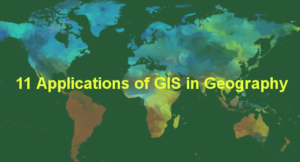The absence of a suitable online platform can seem daunting when dealing with map data. Nevertheless, armed with the right technology – in this case, Geographic Information System (GIS) software – analyzing maps becomes a breeze, devoid of unnecessary complexity.
What is GIS?
GIS, or geographic information system, is a tool that’s a game-changer in data management and analysis. It’s a versatile system that enables the creation, management, analysis, and mapping of diverse data types. With GIS, you get to visualize various layers of mapping data, enabling the identification of trends and changes within a particular area.
Accurate information about underground utility lines is paramount for construction companies and public works departments. This is where GIS companies specializing in utility mapping services come into play. These companies offer intricate and real-time solutions for mapping underground utilities.
They produce 2D and 3D maps, making it invaluable for public works departments to locate and manage underground utility lines precisely. From assisting in property development projects to mapping entire cities, utility mapping services emerge as a vital resource. These GIS companies leverage CAD, GPS, and GIS data conversion software to translate data into highly informative maps, a cornerstone for numerous utility projects.
Advantages of GIS Utility Mapping
1. Real-Time Data Access
One of the shining features of a real-time GIS system is its ability to analyze and display information from many sensors and devices simultaneously. This feature is particularly beneficial when dealing with multiple projects concurrently. With its data collection and processing prowess, forecasting capabilities, collective intelligence, real-time alerts, and distributed problem-solving approach, GIS adds a layer of sophistication to underground utility mapping. It keeps you updated on the precise underground scenario, empowering effective problem-solving with the right expertise and resources.
2. Enhancing Responsiveness
In the modern landscape, GIS streamlines operations, fostering efficient working methods. It enables the seamless sharing of real-time information between field workers and utility service professionals, equipping them with the tools necessary for receiving and recording crucial data. This streamlined approach reduces disaster response times, curbs paperwork, and facilitates quicker and more informed decision-making processes. Consider a scenario where a service request is received; utility managers can track field vehicles, determine the closest worker to the site, and redirect resources as needed. The outcome? Enhanced employee productivity and a boost in customer service quality.
3. Optimized Information Management
Professionals often find themselves juggling multiple mapping applications to fulfill client requirements. However, GIS solutions allow for software consolidation, potentially requiring only one application to handle all data collection and sharing needs. This integration simplifies data sharing within the GIS system, establishing a framework for efficient decision-making. This smarter approach enhances operational efficiency, ensuring that client’s needs are met effectively.
4. Sustainable Resource Management
GIS technology aids environmental agencies in effectively managing and tracking natural resources. Geospatial mapping pinpoints the exact locations and quantities of resources, such as mineral deposits, enabling informed decision-making regarding their management. Additionally, this technology tracks human intervention impacts on the environment, whether it’s deforestation or climate change, thereby contributing to more sustainable resource utilization.
5. Efficiency in Services and Logistics
The shipping and logistics landscape has transformed thanks to geospatial technology that helps make facility management easier. This has facilitated the global delivery of goods and services by companies like Amazon. Key industry players harness GIS data to monitor products, vehicles, traffic conditions, weather patterns, and customer locations, ensuring that deliveries are made precisely and efficiently.
6. Accelerated Decision-Making
Perhaps one of the most potent advantages of GIS is its ability to offer accurate visualization through mapping. GIS amalgamates land-related data like zoning, permitting, parks, and developments with conventional road maps and aerial views. This mapping prowess empowers staff to present pertinent data during official city meetings by focusing on the specific components that warrant attention. This not only enhances comprehension but also expedites decision-making processes.
Final Thoughts
The union of GIS and utility mapping ushers in a new era of data-driven efficiency. The advantages span real-time insights, streamlined operations, enhanced resource management, improved services, and expedited decision-making. GIS emerges as the beacon guiding industries toward a brighter and more effective future in a world defined by information and its strategic application.



